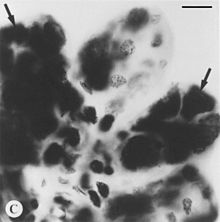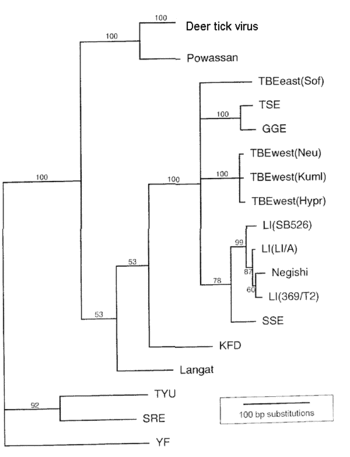- Deer tick virus
-
Deer tick virus 
Black and white microphotograph of Feulgen stained, intact tick salivary glands infected by deer tick virus. Hypotrophied salivary acinus filled with amorphous masses of pinkstaining (=Feulgen positive) material (arrows). Scale bar = 10 µm. Virus classification Group: Group IV ((+)ssRNA) Family: Flaviviridae Genus: Flavivirus Species: Powassan virus Deer tick virus is a virus causing tick-borne encephalitis.[1]
Deer tick virus is a flavivirus closely resembling Powassan virus (to which it has 94% amino acid sequence identity).[2][3] Because they are so related, deer tick virus is thought to be a genotype of Powassan virus, and also called Powassan virus lineage II.[4]
In 1997, it was isolated from Ixodes scapularis (the deer tick, formerly Ixodes dammini) collected in Massachusetts and Connecticut.[5]
Phylogram
 Phylogram indicating the relationship of deer tick virus to other tick-borne encephalitis group viruses.TBE, tick borne encephalitis; TSE, Turkish sheep encephalitis; GGE, Greek goat encephalitis; LI, louping ill virus; SSE, Spanish sheep encephalitis; KFD, Kyasanur Forest disease virus; TYU, Tyuleniy virus; SRE, Saumarez Reef virus.
Phylogram indicating the relationship of deer tick virus to other tick-borne encephalitis group viruses.TBE, tick borne encephalitis; TSE, Turkish sheep encephalitis; GGE, Greek goat encephalitis; LI, louping ill virus; SSE, Spanish sheep encephalitis; KFD, Kyasanur Forest disease virus; TYU, Tyuleniy virus; SRE, Saumarez Reef virus.
Values above branches indicate bootstrapped confidence values. Branch lengths are proportional to percent similarity in sequence.See also
- Tick-borne encephalitis virus
Footnotes
- ^ Tavakoli NP, Heng W, Dupuis M et al (2009). "Fatal Case of Deer Tick Virus Encephalitis". N. Engl. J. Med.. 360: 2099-2107.
- ^ Kuno G, Artsob H, Karabatsos N, Tsuchiya KR, Chang GJ (November 2001). "Genomic sequencing of deer tick virus and phylogeny of powassan-related viruses of North America". Am. J. Trop. Med. Hyg. 65 (5): 671–6. PMID 11716135. http://www.ajtmh.org/cgi/pmidlookup?view=long&pmid=11716135.
- ^ Beasley DW, Suderman MT, Holbrook MR, Barrett AD (November 2001). "Nucleotide sequencing and serological evidence that the recently recognized deer tick virus is a genotype of Powassan virus". Virus Res. 79 (1-2): 81–9. doi:10.1016/S0168-1702(01)00330-6. PMID 11551648. http://linkinghub.elsevier.com/retrieve/pii/S0168170201003306.
- ^ Ebel GD, Spielman A, Telford SR (July 2001). "Phylogeny of North American Powassan virus". J. Gen. Virol. 82 (Pt 7): 1657–65. PMID 11413377. http://vir.sgmjournals.org/cgi/pmidlookup?view=long&pmid=11413377.
- ^ Telford SR, Armstrong PM, Katavolos P, et al (1997). "A new tick-borne encephalitis-like virus infecting New England deer ticks, Ixodes dammini". Emerging Infect. Dis. 3 (2): 165–70. doi:10.3201/eid0302.970209. PMC 2627606. PMID 9204297. http://www.pubmedcentral.nih.gov/articlerender.fcgi?tool=pmcentrez&artid=2627606.
Zoonotic viral diseases (A80–B34, 042–079) Arthropod-borne Arbovirus encephalitides: Japanese encephalitis (JEV) · Australian encephalitis (MVEV, KUNV) · St. Louis encephalitis (SLEV) · West Nile fever (WNV)Arbovirus encephalitides: Eastern equine encephalomyelitis (EEEV) · Western equine encephalomyelitis (WEEV) · Venezuelan equine encephalomyelitis (VEEV) · Chikungunya (CHIKV) · O'Nyong-nyong fever (ONNV) · Ross River fever (RRV)Viral hemorrhagic fevers: Omsk hemorrhagic fever (OHFV) · Kyasanur forest disease (KFDV/AHFV) · Langat virus (LGTV)Colorado tick fever (CTFV)Mammal-borne Viral hemorrhagic fevers: Lassa fever (LASV) · Venezuelan hemorrhagic fever (GTOV) · Argentine hemorrhagic fever (JUNV) · Brazilian hemorrhagic fever (SABV) · Bolivian hemorrhagic fever (MACV) · LUJV · CHPVHantavirus pulmonary syndrome (ANDV · SNV) Viral hemorrhagic fevers: Ebola virus disease (BDBV, EBOV, SUDV, TAFV) · Marburg virus disease (MARV, RAVV)ParamyxoviridaeHenipavirus encephalitis (HeV, NiV)Multiple vectorsRabies (RABV)Categories:- Encephalitis
- Flaviviruses
- Viral encephalitis
Wikimedia Foundation. 2010.
